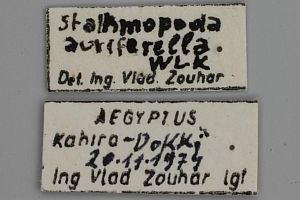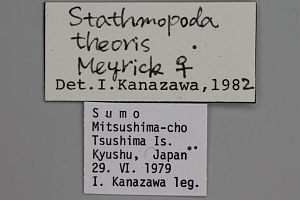

 +11Kontinente:EUASAF
+11Kontinente:EUASAF2. Diagnose
2.1. Genitalien
2.1.1. Weibchen
2.2. Erstbeschreibung
3. Biologie
3.1. Nahrung der Raupe
- [Punicaceae:] Punica granatum (Granatapfel)
- [Actinidiaceae:] Actinidia chinensis [= Actinidia sinensis] [inkl. Actinidia deliciosa ?] (Chinesischer Strahlengriffel, Kiwi)
- [Anacardiaceae:] Mangifera indica (Mango)
- [Rutaceae:] Citrus sinensis (Orange)
- [Poaceae:] Sorghum bicolor (Mohrenhirse)
- [Fabaceae:] Vachellia nilotica [= Acacia nilotica, Acacia arabica] (Ägyptischer Schotendorn)
- [Fabaceae:] Albizia altissima
- [Arecaceae:] Cocos nucifera (Kokospalme)
- [Rubiaceae:] Coffea liberica (Liberica-Kaffee)
- [Rubiaceae:] Coffea canephora [= Coffea robusta] (Robusta-Kaffee, Tiefland-Kaffee)
- [Asteraceae:] Helianthus sp. (Sonnenblume)
- [Asteraceae:] Gynura bicolor
- [Sapindaceae:] Nephelium cuspidatum subvar. ophiodes [= Nephelium ophiodes]
- [Pinaceae:] Pinus roxburghii (Emodi-Kiefer)
- [Myrtaceae:] Tristania (s.l.) sp.
- [Annonaceae:] Melodorum fruticosum
- [Malvaceae:] Hibiscus cannabinus (Hanf-Eibisch, Kenaf)
- [Rosaceae:] Malus domestica (Kultur-Apfel)
- [Rosaceae:] Prunus persica (Pfirsich)
- [Vitaceae:] Vitis vinifera (Weinrebe)
Heckford (2013) berichtet zu seinen zwei mit Granatapfel aus Israel nach England verschleppten Raupen: "The two larvae were in slight silken tubes in the calyx of the pomegranates. The larvae spun slight, whitish, semi-transparent silken tubes amongst the debris at the base of the calyx and appeared to feed on the debris, but were difficult to observe. What was clear was that they do not enter the fruit. The larva that produced the moth fed very slowly from the date of purchase, being provided with fresh calyces of pomegranates from time to time."
Die Angaben von Koster & Sinev (2003) sind wenig konkret: "The larvae live in silken galleries among various types of decaying vegetable matter; sometimes recorded from living flowers, seeds or shoots, injured by other invertebrates [...] Known as a pest of minor importance on agricultural crops."
Der Plant Protection Service, Wageningen, The Netherlands stellt im Artikel "Short PRA - STATHMOPODA AURIFERELLA - November 2009" unter Quellennennung einige Daten zur Art zusammen: CABI (2007) lists the following species as host plants: Citrus sinensis, Mangifera indica. The NHM Host plant database (Robinson et al., 2009) list the following species from 10 different families: Acacia nilotica, Albizia altissima, Cocos nucifera, Coffea sp., Helianthus sp., Mangifera indica, Nephelium ophiodes, Pinus roxburghii, Punica granatum, Sorghum sp., Tristania sp."
[EPPO Reporting Service no. 01 - 2010] melden den Erstfund an importierten Melodorum fruticosum in den Niederlanden und schreiben weiter: "S. auriferella is polyphagous and its larvae are reported to feed mainly on flower buds, flowers and fruits, but there are also records of leaf damage (e.g. on Gynura bicolor and Hibiscus cannabinus). Concerning fruit crops, S. auriferella has been reported on Actinidia sinensis (kiwi), Citrus sinensis (orange), Cocus nucifera (coconut), Coffea spp., Malus domestica (apple), Mangifera indica (mango), Prunus persica (peach) and Vitis vinifera (grapevine). However, data is lacking on the host range of the S. auriferella and its economic impact on the above crops."
4. Weitere Informationen
4.1. Andere Kombinationen
- Gelechia auriferella Walker, 1864 [Originalkombination]
4.2. Synonyme
- Aeoloscelis theoris Meyrick, 1906
4.3. Faunistik
Nach Koster & Sinev (2003) ist die Art in der Orientalischen und Afro-tropischen Region weit verbreitet, in der Palaearktis nur in Gegenden mit subtropischem Klima, also im Nahen Osten und im fernen Osten Russlands.
Nel & Nel (2003: 278) melden zwei in Griechenland, Insel Kreta, Hersonissos gefundene ♂♂: « L'habitus et les genitalia (fig. 1) sont conformes à la révision de cette espèce réalisée par Kasy (1973). ».
Wir akzeptierten die Art hier zunächst nicht als Faunenbestandteil Europas, weil der Fund von zwei Exemplaren natürlich noch keine Bodenständigkeit bewies, aber auch, weil Kasy (1973: 257) – wenn auch minimale – Restzweifel hegte (siehe unten, Typenmaterial), ob das einzige von Erstbeschreiber erhaltene, abdomenlose Exemplar mit der Art konspezifisch ist, die Kasy als S. auriferella auffasst. Die Tiere scheinen aber zumindest gut zu dem zu passen, was man sonst in der Paläotropis unter diesem Namen versteht.
In [EPPO Reporting Service no. 01 - 2010] ist zu erfahren: "The NPPO of the Netherlands recently informed the EPPO Secretariat of the detection of 1 adult specimen of Stathmopoda auriferella (Lepidoptera: Oecophoridae) on an ornamental plant of Melodorum fruticosum (Annonaceae) as a result of monitoring activities. The plants were growing in glasshouses and had been imported from Thailand. The insect was detected on the 2009-07-29. No particular phytosanitary measures will be taken. The pest status of Stathmopoda auriferella in the Netherlands is officially declared as: Absent, intercepted only."
Heckford (2013) berichtet über einen Nachweis in Großbritannien, der aber ganz eindeutig auf Einschleppung beruht und keinerlei Hinweis auf eine Etablierung liefert: "On 9 April 2006 I reared a male Stathmopoda auriferella (Walker, 1864) from one of two larvae found in the calyx of a pomegranate (Punica granatum L.), stated origin Israel, purchased at a superstore at Plymouth, Devon (V.C. 3) on 30 October 2005."
Granatäpfel aus Israel - aber auch andere Früchte aus dem Nahen Osten - finden sehr oft den Weg nach Europa. Die Art sollte entsprechend schon öfter unerkannt in Europa eingeschleppt worden sein. Und die Frage einer möglichen (wenigstens temporären) Bodenständigkeit im südöstlichen, noch zu Europa gehörenden Mittelmeerraum, ist keinesfalls ganz zu verwerfen. Bis zum Beweis des Gegenteils wird sie hier jetzt als unbeständige Adventivart für Europa aufgenommen.
Wenig überraschend ist der Erstnachweis der Art auf den Kanarischen Inseln (Gran Canaria), von dem Falck & Karsholt (2019: 327-328) berichten; sie kommentieren: "Probably an adventive species which is already established on the southern part of Gran Canaria."
(Autoren: Jürgen Rodeland & Erwin Rennwald)
4.4. Typenmaterial
Kasy (1973: 257): „Gelechia? auriferella Walker: Locus typicus: W-Afrika: Sierra Leone. Lectotypus ♂ (hier festgelegt): “Lectotype” “Type” “38, 11. 8., 546” “Sierra Leone” “Gelechia? auriferella” “Lectotype ♂, Gelechia? auriferella Walker, teste K. Sattler, 1968” (BM). Das Exemplar besitzt kein Abdomen mehr und ist auch sonst schlecht erhalten, weitere als Syntypen aufzufassende Stücke waren nicht zu finden und aus der Beschreibung ist nicht ersichtlich, ob solche vorhanden sein sollten. Es kann aber kaum ein Zweifel bestehen, daß es sich bei der Art um die im folgenden als Stathmopoda auriferella aufgefaßte handelt.“
4.5. Literatur
- Bippus, M. (2016): Notes on Lepidoptera from the Seychelles. — Phelsuma 24: 35-71. [PDF auf islandbiodiversity.com]
- Falck, P. & O. Karsholt (2019): New data on Praydidae, Oecophoridae, Stathmopodidae, Scythrididae and Cosmopterigidae from the Canary Islands, Spain (Insecta: Lepidoptera). — SHILAP Revista de Lepidopterología 47 (186): 325-340. [PDF auf redalyc.org]
- Heckford, R. J. (2013): Stathmopoda auriferella (Walker, 1864) (Lepidoptera: Oecophoridae) an adventive species new to the British Isles. — Entomologist’s Gazette 64: 7-10 [PDF auf devonmoths.org.uk].
- Lectotypus-Festlegung: Kasy, F. (1973): Beitrag zur Kenntnis der Familie Stathmopodidae Meyrick, 1913 (Lepidoptera, Gelechioidea). — Tijdschrift voor entomologie 116: 227-299 [Digitalisat auf archive.org].
- Koster, S. J. C. & S. Yu. Sinev (2003): Momphidae, Batrachedridae, Stathmopodidae, Agonoxenidae, Cosmopterigidae, Chrysopeleiidae. — In: Huemer, P., Karsholt, O. & L. Lyneborg [ed.]: Microlepidoptera of Europe 5: 1-387. Stenstrup (Apollo Books).
- Nel, J. & A. Nel (2003): Contribution à la connaissance des Lépidoptères de l'île de Crète (Grèce) (Lepidoptera). — Bulletin de la Société entomologique de France 108 (3): 277-282. [PDF auf persee.fr]
- Erstbeschreibung: Walker, F. (1864): List of the Specimens of Lepidopterous Insects in the Collection of the British Museum 30: 837-1096. London.



















